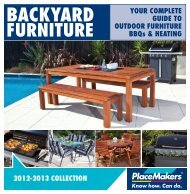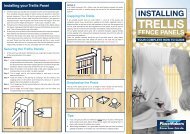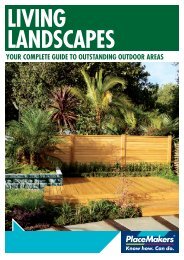your complete guide to outstanding outdoor areas - PlaceMakers
your complete guide to outstanding outdoor areas - PlaceMakers
your complete guide to outstanding outdoor areas - PlaceMakers
You also want an ePaper? Increase the reach of your titles
YUMPU automatically turns print PDFs into web optimized ePapers that Google loves.
H<br />
3 . 2<br />
TIMBER SELECTION GUIDE<br />
For wood exposed <strong>to</strong> the weather<br />
but not in ground contact.<br />
H<br />
4<br />
H<br />
5<br />
APPLICATION<br />
TYPICAL USES<br />
• Decking / Joists / Bearers<br />
• Fence palings, fence rails<br />
and trellis<br />
• Cladding<br />
TIMBER<br />
TREATMENT<br />
CONSUMER<br />
INFORMATION AND<br />
HANDLING GUIDE<br />
FOR CCA PRESSURE<br />
TREATED TIMBER<br />
The Chromated Copper Arsenate<br />
(CCA) preservative used <strong>to</strong> treat<br />
<strong>outdoor</strong> Radiata Pine reacts with the<br />
wood <strong>to</strong> form chemical complexes<br />
that are highly insoluble and leach<br />
resistant. The CCA preservative<br />
penetrates deeply in<strong>to</strong> and will<br />
remain in the wood for a long<br />
period of time. However, some<br />
preservative may migrate from the<br />
preserved wood in<strong>to</strong> surrounding<br />
soil over time and there may also be<br />
incidental contact with skin during<br />
construction or use.<br />
APPLICATION<br />
For wood exposed <strong>to</strong> the weather<br />
and in ground contact.<br />
APPLICATION<br />
For wood exposed <strong>to</strong> the<br />
weather, in ground and fresh<br />
water contact; and in high<br />
risk, load-bearing structural<br />
applications.<br />
TYPICAL USES<br />
Non structural use.<br />
• Fence posts<br />
• Pergola posts<br />
• Retaining wall TGV and lumber<br />
TYPICAL USES<br />
• Piles (house foundations,<br />
retaining walls and decking piles)<br />
• Vineyard supports<br />
• Verandah posts<br />
• Poles<br />
RECOMMENDATIONS<br />
• Do not burn preserved wood (See<br />
Disposal information below)<br />
• Wear a dust mask (P1 or better – AS/<br />
ZS 1716) and goggles when cutting or<br />
handling wood<br />
• Wear gloves when working with wood<br />
• All sawdust and construction debris<br />
should be cleared up and disposed of<br />
after construction<br />
• After working with the wood wash<br />
exposed <strong>areas</strong> thoroughly<br />
• Wash work clothes separately from other<br />
household clothing before reuse<br />
• Preserved wood should not be used<br />
where it may come in<strong>to</strong> direct or indirect<br />
contact with drinking water exp for uses<br />
involving incidental contact such as fresh<br />
water docks and bridges<br />
• Do not use preserved wood under<br />
circumstances where the preservative may<br />
become a component of food, animal<br />
feed or beehives<br />
• Do not use preserved wood for mulch<br />
• Only preserved wood that is visibly clean<br />
and free of surface residue should be<br />
used for patios, decks and walkways<br />
• Do not use preserved wood shavings or<br />
sawdust as animal litter<br />
• Use light spirit based preservative or<br />
sealing agent on all cut, notched or<br />
drilled surfaces<br />
DISPOSAL<br />
• Preserved wood may be disposed of<br />
in landfills or burned in commercial<br />
or industrial incinera<strong>to</strong>rs or boilers in<br />
accordance with National and Regional<br />
rules and regulations.<br />
25
















